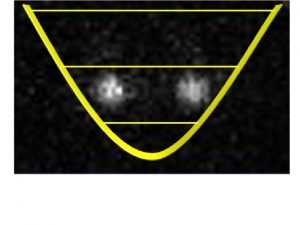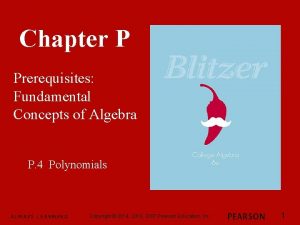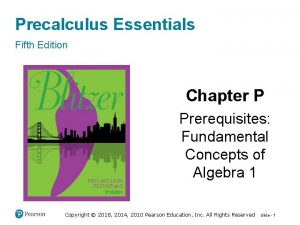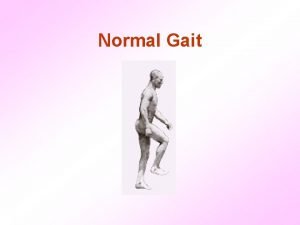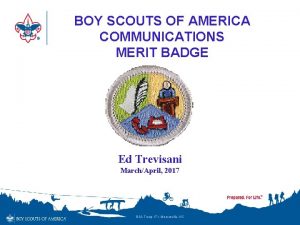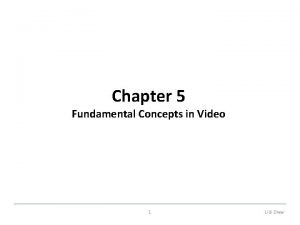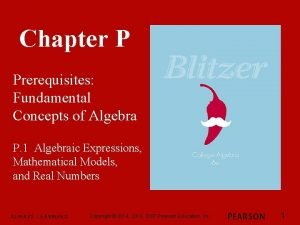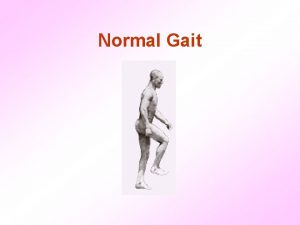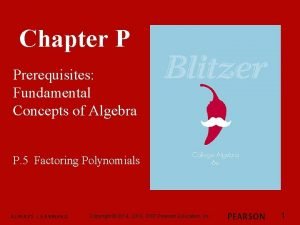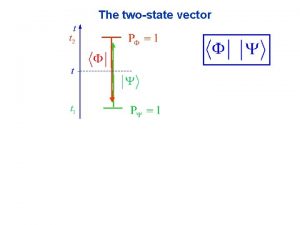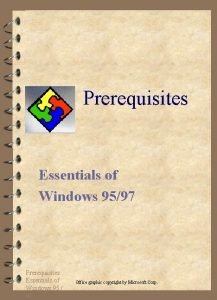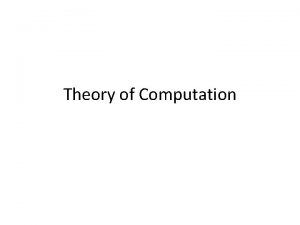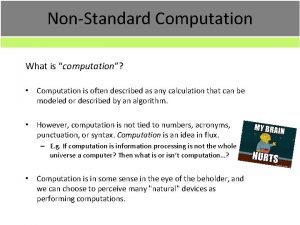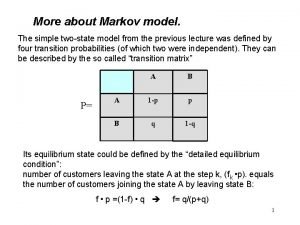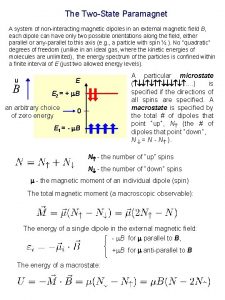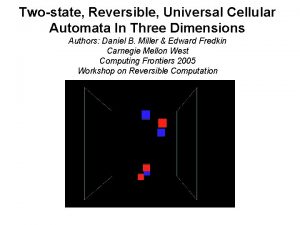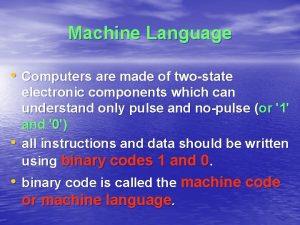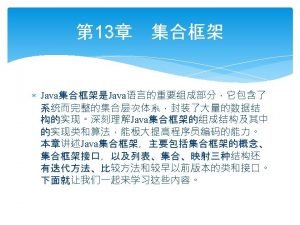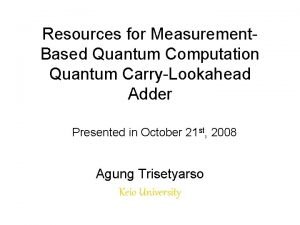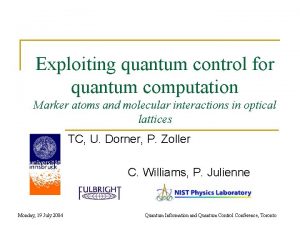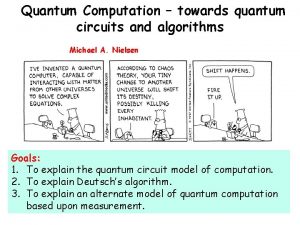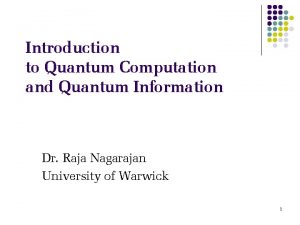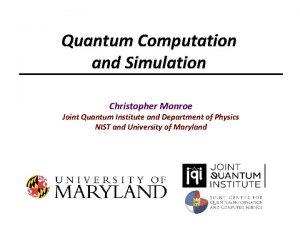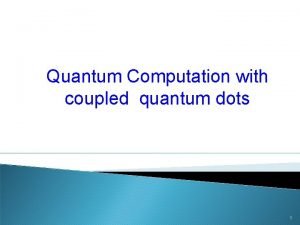Prerequisites for quantum computation Collection of twostate quantum







































- Slides: 39


Pre-requisites for quantum computation Collection of two-state quantum systems (qubits) time Initialise qubit to single state Detect qubit state Operations which manipulate isolated qubits or pairs of qubits Large scale device: Transport information around processor/distribute entangled states Perform operations accurately enough to achieve fault-tolerant error-correction (accuracy ~ 0. 9999 required)

Ion trap (NIST John Jost) RF RF ground DC RF RF RF ground

Isolating single charged atoms Laplace‘s equation – no chance to trap with static fields Paul trap: Use a ponderomotive potential – change potential fast compared to speed of ion Time average - Effective potential energy which is minimal at minimum E

Traps – traditional style DC RF RF electrode Axial potential gives almost ideal harmonic behaviour n=2 n=1 n=0

Multi-level atoms 40 Ca+ - fine structure 9 Be+ - hyperfine structure (16 Hyperfine states)

Requirement: long decay time for upper level.

Storing qubits in an atom - phase coherence Problem: noise! – mainly from classical fields

Storing qubits in an atom Field-independent transitions F = 1 119. 645 Gauss 1 GHz 1207 MHz F = 2 Langer et al. PRL 95, 060502 (2005) Time (seconds!)

Entanglement for protection Rejection of common-mode noise Now consider entangled state If noise is common mode, entangled states can have very long coherence times Haffner et al. , Appl. Phys. B 81, 151 -153 (2005)

Preparing the states of ions Optical pumping – state initialisation Use a dipole transition for speed Example: calcium Calcium: scatter around 3 photons to prepare

Reading out the quantum state Imaging system Photon scattered every 7 ns BUT we only collect a small fraction of these Need to scatter 1000 photons to detect atom

Measurement – experiment sequence Initialise Manipulate Detect How many photons? Statistics: repeat the experiment many (1000) times Number of photons = 8, 4, 2, 0, 0, 1, 5, 0, 0, 8 ….

Single shot measurement “Realization of quantum error-correction“, Chiaverini et al. , Nature 432, 602, (2004) Target Classical processing “If you get 1, 0, do Y, else do X“ Ancilla Measurement: “ 8 counts, this qubit is 1!“ Accuracy of 0. 9999 achieved in 150 microseconds Myerson et al. Phys. Rev. Lett. 100, 200502, (2008)

Manipulating single qubits Laser-driven, quadrupole Counts Resonant microwaves, hyperfine Raman transition, hyperfine

Addressing individual qubits Intensity addressing Shine laser beam at one ion in string Image: Roee Ozeri 2 -4 μm Separate ions by a distance much larger than laser beam size 240 μm Frequency addressing

Multiple qubits: interactions

Multiple ions: coupled harmonic oscillators Expand about equilibrium – equation of motion Independent oscillators - shared motion

The original thought Cirac and Zoller, PRL (1995) “The collective oscillator is a quantum bus“

The forced harmonic oscillator Classical forced oscillator “returns“ after Radius of loop

Forced quantum oscillators Transient excitation, phase acquired

State-dependent excitation

Two-qubit gate, state-dependent excitation Force is out of phase; excite Stretch mode Force is in-phase; excite COM mode

Examples: quantum computing Choose the duration and power: Universal two-qubit ion trap quantum processor: Hanneke et al. Nature Physics 6, 13 -16 (2010)

Laser-driven multi-qubit gates basis, polarisation standing wave Leibfried et al. Nature 422, 412 -415 (2003) F F basis, interference effect

State and entanglement characterisation Detect 8, 6, 7, 4, 9, 0, 0, 1, 1, 6, 1, 9, 0, 0… 5, 4, 3, 11, 4, 1, 0, 0, 1, 8, 0, 8, 1, 0… Entanglement – correlations… Choose 12 different settings of Qubits in the same state Reconstruct density matrix Qubits in different states F = 0. 993 (Innsbruck) Benhelm et al. Nat. Phys 4, 463(2008)

Quantum simulation with trapped-ions Creation of “condensed-matter“ Hamiltonians (Friedenauer et al. Nat. Phys 4, 757 -761 (2008) Kim et al. Nature 465, 7298 (2010)) Go to limit of large motional detuning (very little entanglement between spin and motion)

Dealing with large numbers of ions Technical requirement Spectral mode addressing Many ions Simultaneous laser addressing Limitation Mode density increases Heating rates proportional to N Ions take up space (separation > 2 micron) Laser beams are finite-size

Entanglement of multiple ions Monz et al. , PRL 106, 130506 (2011) High contrast – 3 ions Reduced contrast – 14 ions

Isolate small numbers of ions Wineland et al. J. Res. Nat. Inst. St. Tech, (1998) “coolant“ ion Technological challenge – large numbers of electrodes, many control regions

Distributing entanglement: probabilistic "Click" 50/50 beamsplitter "Click" Entangled ions separated by 1 m ( Moehring et al. Nature 449, 68 (2008) )

Transport with ions 240 μm Move: 20 us, Separate 340 us, 0. 5 quanta/separation Internal quantum states of ions unaffected by transport Motional states are affected – can be re-initialised Total transport distance = 1 mm Zone A Separation Zone B 10 ms J. P. Home et al. Science 325, 1228 (2010)

Trapping ions on a chip For microfabrication purposes, desirable to deposit trap structures on a surface (Chiaverini et al. , Quant. Inf. & Computation (2005), Seidelin et al. PRL 96, 253003 (2006)) end view of quadrupole electrodes Field lines: trap axis Challenges: shallow trap depth (100 me. V) charging of electrodes RF electrodes Control electrodes Opportunities: high gradients

Transporting ions on a (complicated) chip J. Amini et al. New. J. Phys 12, 033031 (2010)

Integrated components 1 Vandevender et al. PRL 105, 023001 (2010)

Integrated components eg. Quantum control using microwaves – removes the need for high-power lasers Gradients – produce state-dependent potentials through Zeeman shifts Single-qubit gate 2 -qubit gate C. Ospelkaus et al. Nature 182, 476 (2011)

Trapped-ions and optical clocks e. g. Rosenband et al. , Science 319, 1808 (2008) Frequency standards Aluminium ion Laser 167 nm 267 nm Require very stable ion transition Has a very stable transition BUT 167 nm is vacuum UV

Atomic clocks – quantum logic readout Shared motion Aluminium “Clock” ion: Beryllium Cooling and readout ion “Allowed” (scatter lots of photons) Most accurate and precise frequency standards – 8 e-18 fractional uncertainty (Chou et al. PRL 104, 070802 (2010))

Trapped-ion summary Have achieved quantum control of up to N ions Have demonstrated all basic components required to create large scale entangled states Algorithms & gates include Dense-coding, error-correction, Toffoli, Teleportation, Entanglement purification Entanglment swapping Working on: Higher precision New manipulation methods Scaling to many ions
 Quantum computing prerequisites
Quantum computing prerequisites Landsat collection 1 vs collection 2
Landsat collection 1 vs collection 2 D/a 30 days
D/a 30 days Classical mechanics
Classical mechanics Quantum physics vs quantum mechanics
Quantum physics vs quantum mechanics What are the 5 r's in note-taking?
What are the 5 r's in note-taking? Klube planning
Klube planning Chapter p prerequisites
Chapter p prerequisites Chapter p prerequisites
Chapter p prerequisites Glendale community college transcript
Glendale community college transcript Normal gait medical term
Normal gait medical term Ucla nursing statement of purpose examples
Ucla nursing statement of purpose examples Group discussion topics
Group discussion topics Communications merit badge
Communications merit badge Forceps prerequisites mnemonic
Forceps prerequisites mnemonic Chapter p prerequisites fundamental concepts of algebra
Chapter p prerequisites fundamental concepts of algebra Waterloo pharmacy prerequisites
Waterloo pharmacy prerequisites Prerequisites of gait
Prerequisites of gait Health education topics for primary school students
Health education topics for primary school students Glendale college transcripts
Glendale college transcripts Uw pharmacy prerequisites
Uw pharmacy prerequisites Prerequisites for ssdt
Prerequisites for ssdt Fy22 milper message 20-251
Fy22 milper message 20-251 Selection introduction
Selection introduction Prerequisites of performance management
Prerequisites of performance management Prerequisites fundamental concepts of algebra
Prerequisites fundamental concepts of algebra Examples of prerequisite programs for haccp
Examples of prerequisite programs for haccp Glendale community college nursing application
Glendale community college nursing application Pcnse pearson vue
Pcnse pearson vue Image processing prerequisites
Image processing prerequisites Medical term for normal gait
Medical term for normal gait Ap spanish prerequisites
Ap spanish prerequisites North harris nursing program
North harris nursing program Chapter p prerequisites fundamental concepts of algebra
Chapter p prerequisites fundamental concepts of algebra Inköpsprocessen steg för steg
Inköpsprocessen steg för steg Påbyggnader för flakfordon
Påbyggnader för flakfordon Tack för att ni lyssnade
Tack för att ni lyssnade En lathund för arbete med kontinuitetshantering
En lathund för arbete med kontinuitetshantering Egg för emanuel
Egg för emanuel Tack för att ni har lyssnat
Tack för att ni har lyssnat
